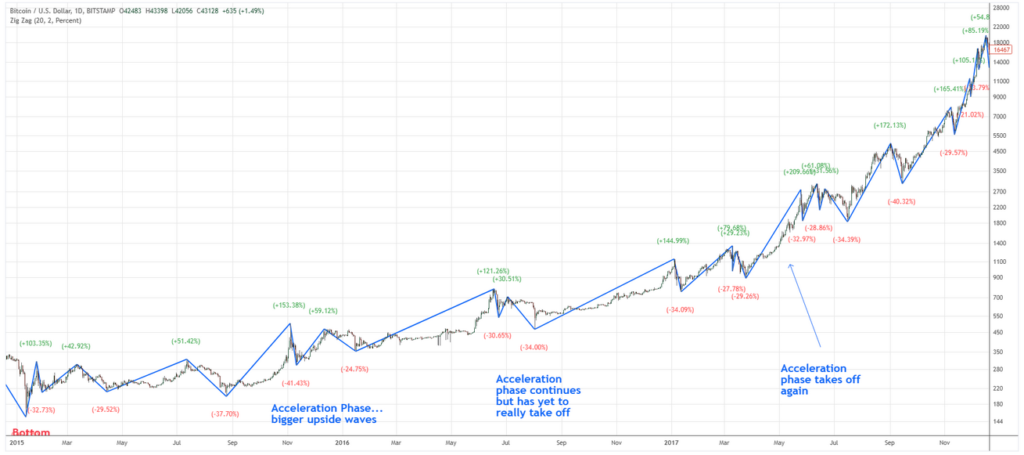
Key Points :
- Venture firm Sigma Capital’s CEO Vineet Budki predicts that Bitcoin may suffer a 65%–70% correction within the next two years.
- Despite this warning, Budki remains bullish on Bitcoin reaching US$1 million+ per coin within the next decade.
- The long-standing four-year halving-cycle narrative for Bitcoin is under increasing challenge; former BitMEX co-founder Arthur Hayes argues that macro-liquidity and institutional flows now dominate.
- Institutional accumulation — more than 4 million BTC (~20 % of total supply) held by governments, ETFs, exchanges and digital asset firms — is changing market structure.
- For crypto investors and blockchain practitioners, the implication is: timing models must evolve, risk-management must tighten, and new asset discovery should focus on utility and institutional readiness.
1. Short-Term Warning: A Possible 65–70% Correction
In a recent interview at the Global Blockchain Congress 2025 in Dubai, Vineet Budki of Sigma Capital warned that Bitcoin may face a major retracement of 65 %–70 % within the next two years. His argument centres on behavioural and structural factors: he emphasises that even if the price falls from eight-figures to, say, US$70,000, Bitcoin would not lose its intrinsic utility — the real risk lies in investor misunderstanding.
He stated: “Even if it drops to US$70,000, Bitcoin will not lose its utility. The problem is that people don’t understand it. When they buy assets they don’t understand, they are the first to sell. That generates the selling pressure.”
In other words: a deep correction may follow if retail or less-experienced participants become spooked, triggering cascade selling — even as the underlying utility remains. From a practical point of view, for someone seeking new crypto-asset opportunities or designing token-based systems, this means: expect turbulence, but differentiate between price draw‐down and utility‐decline.
Why this warning matters
This forecast serves as a reminder that even “blue-chip” crypto assets are subject to steep drawdowns — far deeper than many traditional investors might assume. For practitioners building blockchain use-cases or monitoring token launches (for example via ICOs or DeFi platforms), the lesson is: build resilience into your timing, liquidity planning, and narrative.
2. Long-Term Bullish Thesis: US$1 Million Bitcoin in 10 Years
Despite the sharp near-term warning, Budki remains optimistic for the long term. He projects that Bitcoin could exceed US$1 million per coin within the next decade.
His rationale: two complementary growth engines — speculative demand and real-world utility/usage. As crypto infrastructure matures, Bitcoin’s social adoption (payments, treasury use, cross-border settlement) will expand, not just speculative trading.
For blockchain-practitioners seeking to identify “the next revenue source” or new crypto-assets, this dynamic emphasises the importance of usage case over hype. If Bitcoin can still command such long-term upside, then emerging assets that tie into real-world flows may benefit from the same structural tailwinds.
3. Has the Four-Year Halving Cycle Ended?
Historically, Bitcoin’s price has followed a predictable roughly four-year rhythm tied to its halving events: reward reductions → supply shock → rally → sharp correction. But this narrative is under attack.
Arthur Hayes — a prominent crypto-market thinker — argues that the four-year cycle is effectively dead. He asserts that the dominant drivers for Bitcoin’s USD price now stem from global money supply, central-bank policy, and institutional flows rather than simply halving-timing.
He writes: “…the price and supply of dollars are the dominant variables for risk assets” and that “Bitcoin’s earlier peaks aligned with turning points in dollar and yuan liquidity.”
Other analysts echo this shift: While the halving-cycle may retain some descriptive value, the real moving levers now are institutional accumulation, ETF flows, macro-monetary easing/tightening, and global liquidity dynamics.
For token-project builders or crypto-investors, this means: rely less on calendar-based cycles and more on liquidity, institutional structure, and macro-signals.
4. Institutional Adoption: A Structural Game-Changer
One of the key shifts in Bitcoin’s ecosystem is the scale of institutional holdings. Data indicates that over 4 million BTC, roughly 20 % of the total supply, is held by governments, crypto-firms, listed ETF products, and exchanges.
Such concentration has several implications:
- Liquidity-pull: Large holders tend to exert influence on supply and price action — accumulation or distribution by such entities can dwarf retail flows.
- Volatility dampening or skewing: With more “long-term” holders, rather than short-term traders, drawdowns may be deeper but slower, or recoveries more muted — the old quick “boom & bust” may morph into “boom, long plateau, then bust”.
- Market access and infrastructure: Institutional involvement brings with it regulated products (ETFs, futures, custody services), changing the way assets trade and how tokens launch.
- Narrative shift: Bitcoin is increasingly viewed not only as a speculative asset but as a reserve or treasury asset — this changes flow behaviour, valuation frameworks, and what “utility” means.
For a developer or financial institution planning blockchain integration (wallets, swaps, token issuance), the structural role of institutional flows means you must consider token-economics, institutional access, and enterprise usage earlier in your design, not just retail adoption.
5. Practical Implications for Investors & Blockchain Builders
For those reading this article who are hunting new crypto-assets, seeking next-gen revenue models, or designing blockchain systems, here are actionable take-aways:
a) Timing & Risk-Management
- Given Budki’s warning, avoid assuming linear upside; build in risk buffers for 60%–70% drawdowns.
- Instead of anchoring solely on halving-dates, monitor macro indicators: central bank communications, global liquidity measures, ETF inflows/outflows, institutional net positions.
- For token projects, ensure liquidity planning, vesting schedules, and market-entry mechanisms are robust against a steep drop.
b) Utility over Hype
- As Hayes emphasises, the next alt-cycle will not resemble 2021’s broad hype phase. Fundamental metrics (users, revenue, token burn, ecosystem adoption) matter more.
- If you are designing or evaluating a token project (the user said they are working on a wallet, token issuance etc), align early with real-world use: payments, remittances, wallet-swaps, institutional treasury flows — not only speculative listing.
c) Token Design & Institutional Access
- Considering institutional holdings now matter, token models should contemplate institutional investor onboarding, regulated custody, compliance (e.g., KYC/AML) and treasury-use cases.
- If building a wallet or swap interface (as you are), integrating features like non-custodial swaps, transparent settlement, institutional-grade custody or staking may differentiate you in a maturing market.
d) Portfolio Strategy for New Crypto Assets
- Allocate exposure to new assets with awareness that broader market may still face sharp correction.
- Focus on assets or projects that can survive a 60%+ drawdown — i.e., have utility, real-world partnerships, resilient tokenomics.
- In your token-launch planning (you mentioned upcoming ICO/presale), ensure marketing and infrastructure account for volatility: e.g., escrow mechanisms, phased distributions, vesting to avoid “panic-sell” from uninformed participants (a point Budki emphasises).
6. Chart Insert – Bitcoin Historical Corrections
This visual shows past Bitcoin drawdowns (60–80 % in previous bear markets) and supports why a 65–70 % warning is plausible.

7. Conclusion: Correction Ahead, But Opportunity Still Alive
In summary, the crypto market is at a complex juncture. On one hand, Vineet Budki of Sigma Capital presents a sober near-term warning of a potential 65 %–70 % correction in Bitcoin. On the other, he affirms a long-term bullish view towards US$1 million+ per coin in the coming decade. Meanwhile, Arthur Hayes and others argue that the old “four-year halving” clockwork is breaking down, and instead macro-liquidity, institutional flows and real-world adoption are now the dominant forces.
For investors seeking new crypto assets, and practitioners building blockchain infrastructure, the message is clear: expect volatility, focus on utility, and design for both institutional and retail participation. A deep correction may well lie ahead, but that drawdown could in turn fertilize the next cycle of accumulation — for those prepared.
If you like, I can pull up specific altcoins or token projects that look well-positioned for this environment (utility-focused, institutional-ready, resilient tokenomics). Would you like me to prepare that?

